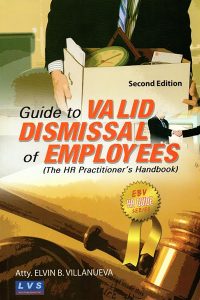Hazards of Terminating an Employee Part 2
This is a continuation of the post on Hazards of Terminating an employee. The post is based on the book Guide to Valid Dismissal of Employees (pp. 6-7)
 As mentioned, it is easy for complainants to file the case against the employer which makes it more challenging for the latter.
As mentioned, it is easy for complainants to file the case against the employer which makes it more challenging for the latter.
All the complainant has to do is to go to the nearest office of the Department of Labor and Employment and fill out a Request for Assistance under the Single Entry Approach (SENA). If settlement is not made in SENA, he can then proceed to the NLRC to file the case after obtaining an endorsement.
The unfortunate employer may be held liable for illegal dismissal for which he may be ordered to reinstate the complainant and pay backwages, damages and separation pay, among others, as the case may be.
To appreciate the impact of an illegal dismissal in the company’s resources, the accompanying legal consequences shall be discussed as a general perspective:
(1) Backwages. One of the most painful effects of illegal dismissal on the part of the employer is the payment of backwages. It represents compensation that should have been earned by the employee but were lost because of the unjust or illegal dismissal.
Backwages ordinarily should be computed from the time the compensation was withheld (which, as a rule, is from the time of illegal dismissal) up to the time of reinstatement, actual or in the payroll.
For example, employee X was dismissed on March 5, 2000. He filed a complaint for illegal dismissal. Subsequently, X won the case with finality in the Supreme Court on March 5, 2014. His backwages will be computed from his date of dismissal up to the time of actual reinstatement following the finality of the decision of the Supreme Court. Thus, assuming the date of reinstatement is March 5, 2014, the period from March 5, 2000 to March 5, 2014 constitutes a total of fourteen (14) years which must be paid the backwages on a monthly basis as if X was still earning his salary during those times.
Practically, the employer is made liable for the dismissed employee’s salary even though the employee rendered no equivalent service. Backwages are penalties in accordance with violation of public policies. It replaces salaries and is created by fiction of law to penalize the employer for effecting an illegal dismissal.
On the part of the employer, there is no actual value in exchange for such payment.
(2) Reinstatement Another painful consequence of a judgment of illegal dismissal is the reinstatement aspect. The employer may be ordered to readmit the dismissed employee to work and restore the relationship. This is called reinstatement under the Labor Code.

Comments (8)
… [Trackback]
[…] Find More here on that Topic: lvsbooks.com/hazards-terminating-employee-part-2/ […]
… [Trackback]
[…] Read More on that Topic: lvsbooks.com/hazards-terminating-employee-part-2/ […]
… [Trackback]
[…] Here you can find 77016 additional Information on that Topic: lvsbooks.com/hazards-terminating-employee-part-2/ […]
… [Trackback]
[…] Read More on that Topic: lvsbooks.com/hazards-terminating-employee-part-2/ […]
… [Trackback]
[…] Read More here on that Topic: lvsbooks.com/hazards-terminating-employee-part-2/ […]
… [Trackback]
[…] Info to that Topic: lvsbooks.com/hazards-terminating-employee-part-2/ […]
… [Trackback]
[…] Read More on on that Topic: lvsbooks.com/hazards-terminating-employee-part-2/ […]
… [Trackback]
[…] There you will find 37149 more Information on that Topic: lvsbooks.com/hazards-terminating-employee-part-2/ […]
Comments are closed.